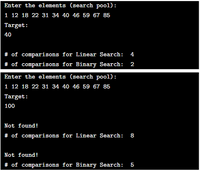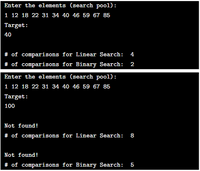
Write a Java program that implements both Linear Search and Binary Search. The program will
take a collection of objects (generic type data) as input and print the number of comparisons needed
to find a target element within that collection.
You will create the following two Java classes:
1. SearchCombo.java : Code for both linearSearch and binarySearch will be in this class. You
may take help from the textbook Chapter 9, Section 9.1. However, note that the design require-
ments are different from the textbook code.
•Both search methods must use the Comparable<T> interface and the compareTo() method.
•Your program must be able to handle different data types, i.e., use generics.
•For binarySearch, if you decide to use a midpoint computation formula that is different from
the textbook, explain that formula briefly as a comment within your code.
2. Tester.java : This class will contain the main() method. The user will be asked to enter the
collection of elements (comma or space can be used to separate the elements). The output will
be the number of comparisons the two searching techniques require.
Review the sample output given below to get an idea of what the program output should look like.

Trending nowThis is a popular solution!
Step by stepSolved in 2 steps

take a collection of objects (generic type data) as input and print the number of comparisons needed
to find a target element within that collection.
You will create the following two Java classes:
1. SearchCombo.java : Code for both linearSearch and binarySearch will be in this class. You
may take help from the textbook Chapter 9, Section 9.1. However, note that the design require-
ments are different from the textbook code.
•Both search methods must use the Comparable<T> interface and the compareTo() method.
•Your program must be able to handle different data types, i.e., use generics.
•For binarySearch, if you decide to use a midpoint computation formula that is different from
the textbook, explain that formula briefly as a comment within your code.
collection of elements (comma or space can be used to separate the elements). The output will
be the number of comparisons the two searching techniques require.
Review the sample output given below to get an idea of what the program output should look like.
Your output may include additional information.
public static <T>
boolean linearSearch(T[] data, int min, int max, T target) {
int index = min;
boolean found = false;
while (!found && index <= max) {
found = data [index].equals(target);
index++;
}
return found;
}
public static <T extends Comparable<T>>
boolean binarySearch(T[] data, int min, int max, T target) {
boolean found = false;
int midpoint = (min + max)/2;
if (data[midpoint].compareTo(target)==0)
found = true;
else if(data[midpoint].compareTo(target)>0) {
if(min<=midpoint-1)
found = binarySearch(data, min, midpoint-1, target);
}
else if (midpoint+1<=max)
found=binarySearch(data, midpoint+1, max, target);
return found;
}
}

take a collection of objects (generic type data) as input and print the number of comparisons needed
to find a target element within that collection.
You will create the following two Java classes:
1. SearchCombo.java : Code for both linearSearch and binarySearch will be in this class. You
may take help from the textbook Chapter 9, Section 9.1. However, note that the design require-
ments are different from the textbook code.
•Both search methods must use the Comparable<T> interface and the compareTo() method.
•Your program must be able to handle different data types, i.e., use generics.
•For binarySearch, if you decide to use a midpoint computation formula that is different from
the textbook, explain that formula briefly as a comment within your code.
collection of elements (comma or space can be used to separate the elements). The output will
be the number of comparisons the two searching techniques require.
Review the sample output given below to get an idea of what the program output should look like.
Your output may include additional information.
public static <T>
boolean linearSearch(T[] data, int min, int max, T target) {
int index = min;
boolean found = false;
while (!found && index <= max) {
found = data [index].equals(target);
index++;
}
return found;
}
public static <T extends Comparable<T>>
boolean binarySearch(T[] data, int min, int max, T target) {
boolean found = false;
int midpoint = (min + max)/2;
if (data[midpoint].compareTo(target)==0)
found = true;
else if(data[midpoint].compareTo(target)>0) {
if(min<=midpoint-1)
found = binarySearch(data, min, midpoint-1, target);
}
else if (midpoint+1<=max)
found=binarySearch(data, midpoint+1, max, target);
return found;
}
}

- Java with screen shot pleasearrow_forwardWrite a program RURottenTomatoes.java that creates a 2 dimensional integer array of movie ratings from the command line arguments and displays the index of the movie that has the highest sum of ratings. Ratings range from 1 to 5 (inclusive). The rows of the 2D array correspond to movie reviewers and the columns of the 2D array correspond to movies. The reviewer at index 2 gave movie at index 0 a rating of 4. Take a look at the following example for an explanation on the command line arguments sequenc. The first argument corresponds to the number of reviewers and the second argument corresponds to the number of movies (the dimensions of the 2D integer array). Following are the movie ratings in a row-major order. This means that the first row is filled first, then the second row, etc. In the example above there are 3 reviewers and 2 movies, and the program displays 0 (zero) because the movie at index zero has the highest sum of ratings (movie 0 has sum of ratings equals to 12 while…arrow_forwardWrite a program that uses two classes. The first class is called “dAta” and holds x and y coordinates of a point in 2-d space called p1. The second class is called “cOmpute” and holds an array of two pointers to the “dAta” class. The “cOmpute” class has a function, lOad(float x, float y, int n), which loads x and y coordinate data into the array at index n. It also has a function, sLope(), which computes the slope of the line connecting the two array data coordiantes. It also has a function, pRint(), which prints the slope result to the screen. Implement a divide by zero exception using throw in the sLope() nd/or pRint() function as appropriate. The exception should, when caught, print “Slope calculation error…” to the screen and exit the function. The program should load the array with some example points and print the slope to the screen using the class functions.arrow_forward
- In writing a general-purpose sort method in Java, the sort method needs to compareobjects. There are two ways to give the sort method the code to compare objects,implementing the interfaces Comparable and Comparator respectively. Extend Article class toimplement Comparable interface so that the default sorting of the Articles is by its volumearrow_forwardIN JAVA. Any help is appreciated! Thank you! PART 1 : Automobiles Create a data class named Automobile that implements the Comparable interface. Give the class data fields for make, model, year, and price. Then add a constructor, all getters, a toString method that shows all attribute values, and implement Comparable by using the year as the criterion for comparing instances. Write a program named TestAutos that creates an ArrayList of five or six Automobiles. Use a for loop to display the elements in the ArrayList. Sort the Arraylist of autos by year with Collections.sort(). Finally, use a foreach loop to display the ArrayList sorted by year.arrow_forwardUse java.arrow_forward
 Database System ConceptsComputer ScienceISBN:9780078022159Author:Abraham Silberschatz Professor, Henry F. Korth, S. SudarshanPublisher:McGraw-Hill Education
Database System ConceptsComputer ScienceISBN:9780078022159Author:Abraham Silberschatz Professor, Henry F. Korth, S. SudarshanPublisher:McGraw-Hill Education Starting Out with Python (4th Edition)Computer ScienceISBN:9780134444321Author:Tony GaddisPublisher:PEARSON
Starting Out with Python (4th Edition)Computer ScienceISBN:9780134444321Author:Tony GaddisPublisher:PEARSON Digital Fundamentals (11th Edition)Computer ScienceISBN:9780132737968Author:Thomas L. FloydPublisher:PEARSON
Digital Fundamentals (11th Edition)Computer ScienceISBN:9780132737968Author:Thomas L. FloydPublisher:PEARSON C How to Program (8th Edition)Computer ScienceISBN:9780133976892Author:Paul J. Deitel, Harvey DeitelPublisher:PEARSON
C How to Program (8th Edition)Computer ScienceISBN:9780133976892Author:Paul J. Deitel, Harvey DeitelPublisher:PEARSON Database Systems: Design, Implementation, & Manag...Computer ScienceISBN:9781337627900Author:Carlos Coronel, Steven MorrisPublisher:Cengage Learning
Database Systems: Design, Implementation, & Manag...Computer ScienceISBN:9781337627900Author:Carlos Coronel, Steven MorrisPublisher:Cengage Learning Programmable Logic ControllersComputer ScienceISBN:9780073373843Author:Frank D. PetruzellaPublisher:McGraw-Hill Education
Programmable Logic ControllersComputer ScienceISBN:9780073373843Author:Frank D. PetruzellaPublisher:McGraw-Hill Education





